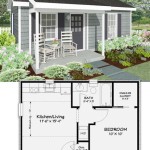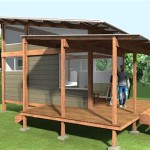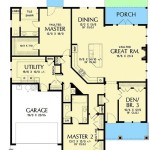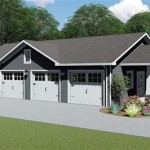Simple House Plans: Affordable and Easy to Build
The dream of homeownership remains a potent aspiration for many. However, the escalating costs associated with traditional construction methods and complex architectural designs can often seem insurmountable. Simple house plans offer a viable alternative, providing an accessible pathway to owning a home without incurring exorbitant expenses or requiring specialized construction expertise. These plans prioritize functionality, efficiency, and ease of construction, making them an attractive option for first-time homebuyers, those seeking to downsize, or individuals interested in building a secondary residence.
The concept of simple house plans revolves around maximizing space utilization while minimizing unnecessary architectural embellishments. This translates to a streamlined building process, reduced material costs, and lower labor expenses. By focusing on essential living areas and employing straightforward construction techniques, these plans create homes that are both practical and financially feasible. The emphasis on simplicity also allows for greater customization options, enabling homeowners to personalize their living spaces to suit their specific needs and preferences.
Key Point 1: Cost-Effectiveness of Simple House Plans
The most significant advantage of simple house plans resides in their cost-effectiveness. Several factors contribute to this affordability. Smaller square footage is often inherent in these designs, which directly translates to reduced material requirements. Less lumber, fewer roofing shingles, and smaller quantities of insulation are all necessary, leading to substantial savings on raw material costs. Furthermore, simplified layouts minimize the need for complex framing and intricate structural elements, further reducing material waste and labor time.
Construction labor constitutes a significant portion of overall building expenses. Simple house plans, with their straightforward designs, require less specialized skills and reduced construction time. Basic carpentry and standard building practices are typically sufficient, lowering the need for expensive contractors and specialized tradespeople. This streamlined construction process not only translates to lower labor costs but also reduces the overall project duration, minimizing potential delays and associated expenses.
Energy efficiency is another area where simple house plans contribute to long-term cost savings. Smaller homes inherently require less energy to heat and cool, resulting in lower utility bills. Efficient insulation, strategically placed windows, and appropriate orientation to the sun can further enhance energy performance, minimizing reliance on expensive heating and cooling systems. These features, often incorporated into simple house plans, contribute to sustainable living and reduced operational costs over the lifespan of the home.
Beyond initial construction costs, simple house plans often lead to lower property taxes due to the smaller square footage and less elaborate design. Home insurance premiums may also be lower, reflecting the reduced risk associated with a simpler structure. These ongoing cost savings contribute to the overall affordability of owning a home built from a simple house plan.
Key Point 2: Ease of Construction and DIY Potential
Simple house plans are designed with ease of construction in mind, making them accessible to a wider range of individuals, including those with limited building experience. The use of standardized materials and straightforward construction techniques simplifies the building process, reducing the likelihood of errors and complications. Clear and concise blueprints, often accompanied by detailed instructions and step-by-step guides, further enhance the DIY potential of these projects.
The absence of complex architectural features, such as intricate rooflines, curved walls, or elaborate trim work, simplifies the framing process and reduces the need for specialized carpentry skills. Basic framing techniques, readily taught in building workshops or through online tutorials, are typically sufficient for constructing the walls and roof of a simple house. Similarly, the installation of windows, doors, and siding is often a straightforward process that can be accomplished with basic tools and readily available materials.
While professional contractors can be hired for specific tasks, such as plumbing and electrical work, many aspects of the construction process can be undertaken by the homeowner, provided they possess the necessary skills and knowledge. This DIY potential allows for significant cost savings, as labor expenses are drastically reduced. Furthermore, the opportunity to participate in the construction of one's own home can be a deeply rewarding experience, fostering a sense of ownership and pride.
For those with limited building experience, it is advisable to start with smaller projects, such as building a shed or a small deck, to gain practical skills and confidence. Consulting with experienced builders or attending building workshops can also provide valuable knowledge and guidance. Careful planning, meticulous execution, and a willingness to learn are essential for success in any DIY construction project.
Key Point 3: Adaptability and Customization Options
Despite their inherent simplicity, simple house plans offer a surprising degree of adaptability and customization options. While the basic layout and structural framework are standardized, homeowners can readily modify the interior design, finish materials, and landscaping to reflect their individual tastes and preferences. This flexibility allows for the creation of a personalized living space that meets specific needs and desires.
The interior layout can be easily customized to accommodate different family sizes and lifestyles. Walls can be moved, rooms can be combined, and additional storage spaces can be added to create a living environment that is both functional and comfortable. The selection of flooring, paint colors, cabinetry, and fixtures provides ample opportunity to personalize the interior aesthetic. The choice of these elements can significantly impact the overall ambiance and style of the home.
The exterior design can also be tailored to suit individual preferences and blend seamlessly with the surrounding environment. Different siding materials, roofing styles, and window designs can be chosen to create a unique exterior appearance. Landscaping plays a crucial role in enhancing the curb appeal and creating an inviting outdoor space. The addition of a deck, patio, or garden can further expand the living area and provide opportunities for relaxation and recreation.
Simple house plans can also be adapted to incorporate energy-efficient features and sustainable building practices. Solar panels, rainwater harvesting systems, and energy-efficient appliances can be integrated into the design to minimize environmental impact and reduce operating costs. These features not only contribute to a more sustainable lifestyle but also enhance the long-term value of the home.
Furthermore, simple house plans can be easily expanded or modified in the future to accommodate changing needs. Additions, such as extra bedrooms, bathrooms, or living spaces, can be incorporated into the existing structure without requiring extensive structural modifications. This adaptability ensures that the home remains functional and comfortable for years to come.
The availability of numerous online resources, including websites, blogs, and forums dedicated to simple house plans, provides homeowners with a wealth of information and inspiration. These resources offer a wide range of design ideas, construction tips, and customization options, enabling homeowners to create a truly personalized and affordable living space. Furthermore, many architects and designers specialize in simple house plans, offering professional assistance in tailoring designs to meet specific needs and preferences.
Simple house plans represent a practical and accessible pathway to homeownership for individuals seeking affordability, ease of construction, and customization options. By focusing on essential living areas, employing straightforward building techniques, and offering flexibility in design, these plans provide a viable alternative to traditional construction methods. The cost-effectiveness, DIY potential, and adaptability of simple house plans make them an attractive option for a wide range of homeowners, from first-time buyers to those seeking to downsize or build a secondary residence. The key lies in careful planning, diligent execution, and a willingness to personalize the design to create a home that is both functional and aesthetically pleasing.
Est House Plans To Build Simple With Style Blog Eplans Com

Stylish And Simple Inexpensive House Plans To Build Houseplans Blog Com

Affordable House Plans Our Est To Build Blog Homeplans Com

Stylish And Simple Inexpensive House Plans To Build Houseplans Blog Com

Stylish And Simple Inexpensive House Plans To Build Houseplans Blog Com

Stylish And Simple Inexpensive House Plans To Build Houseplans Blog Com

Stylish And Simple Inexpensive House Plans To Build Houseplans Blog Com

Stylish And Simple Inexpensive House Plans To Build Houseplans Blog Com

Small House Design 2024001 Pinoy Eplans Floor Plans

Simple House Plans Blog Homeplans Com
Related Posts








